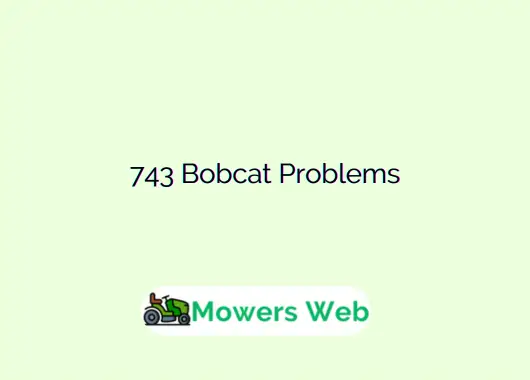The John Deere LA105 is a popular entry-level riding mower known for its reliability, user-friendly design, and durability.
This post covers the most common John Deere LA105 problems, their likely causes, and practical fixes to keep your mower running smoothly.
John Deere LA105 Problems
1. Starting Problems
One of the most frequently reported John Deere LA105 problems is failure to start. Owners often find that the mower won’t crank, has no spark, or turns over but refuses to fire.
Common Causes
- Faulty Safety Switches: The mower is equipped with seat, brake, and blade engagement safety switches. If any of these fail, the mower may not start.
- Weak Battery or Poor Connections: A low battery voltage or corroded terminals can prevent proper cranking.
- Ignition Coil Failure: A bad coil will prevent a spark from reaching the plug.
- Fuel System Issues: Old or contaminated fuel, clogged filters, or a dirty carburetor can cause starting failures.
Recommended Fixes
- Check the battery voltage and clean terminals.
- Inspect all safety interlock switches for proper operation.
- Test the ignition system for spark and replace faulty components if necessary.
- Drain stale fuel, clean the carburetor, and replace the fuel filter.
Related John Deere MX6 Problems(8 Causes + Solutions)
2. Engine Runs Rough, Surges, or Emits Smoke
A rough-running engine, surging, or smoke are also among the John Deere LA105 problems reported by many users. The mower may start but idle poorly or lose power under load.
Common Causes
- Dirty Air Filter: A clogged air filter restricts airflow and causes the engine to run rich, producing black smoke.
- Carburetor Malfunction: Dirt or varnish in the carb jets leads to improper fuel-air mixture.
- Stuck Choke or Throttle Linkage: If the choke is stuck in the closed position, the engine receives too much fuel.
- Head Gasket Leak: White smoke and popping noises may signal a blown head gasket.
Recommended Fixes
- Replace or clean the air filter regularly.
- Clean the carburetor using an appropriate cleaner and tools.
- Check throttle and choke linkages for free movement.
- Perform a compression test if you suspect head gasket issues.
3. Engine Stalls When Blades Are Engaged
Many users experience the engine dying immediately when the mower deck is engaged. This is one of the more frustrating John Deere LA105 problems, especially during peak mowing season.
Common Causes
- Defective PTO or Safety Switch: A malfunctioning safety switch can cut power when the blades are engaged.
- Deck Belt or Pulley Jam: A stuck belt or seized spindle bearing increases load and stalls the engine.
- Clogged Deck: Excessive grass buildup can create heavy resistance during engagement.
Recommended Fixes
- Inspect and test the blade engagement (PTO) switch and safety circuit.
- Check deck pulleys and spindle bearings for wear or seizure.
- Clean debris from under the deck and ensure the belt runs smoothly.
- Make sure blades are properly balanced and sharp.
Related John Deere Power Reverser Transmission Problems(Fixed)
4. Throttle Not Responding
Another issue seen in the LA105 is a non-responsive throttle lever, moving it up or down doesn’t change engine speed.
Common Causes
- Corroded or Stuck Throttle Cable: Rust inside the cable sheath can prevent smooth movement.
- Disconnected Linkage: The throttle cable may pop out of place at either the lever or carburetor end.
- Governor Spring Detached: The governor linkage can unhook or stretch over time.
Recommended Fixes
- Inspect the entire throttle cable for rust, binding, or disconnection.
- Lubricate the cable or replace it if it’s severely corroded.
- Reattach or replace missing governor springs.
- Ensure the throttle plate on the carburetor moves freely.
5. Engine Damage or Head Gasket Failure
Some owners have reported more serious John Deere LA105 problems involving internal engine damage or blown head gaskets, even at low operating hours.
Warning Signs
- Loud metallic knocking or rattling sounds.
- Sudden white or blue smoke from the exhaust.
- Oil leaks or oil spraying near the flywheel.
- Engine overheating or loss of compression.
Common Causes
- Poor Maintenance: Neglecting oil changes or running with low oil levels can cause internal wear.
- Overheating: Clogged cooling fins or a missing shroud can lead to high operating temperatures.
- Foreign Object Damage: Loose components like fan guards may fall into moving parts, causing severe damage.
Recommended Fixes
- Regularly check and maintain oil levels; change oil after every 50 hours of operation.
- Clean the engine cooling fins and replace damaged fan covers or shrouds.
- If you suspect gasket failure, perform a compression test and replace the gasket as needed.
Related How Many Hours Is a Lot for a Lawn Mower(Complete Guide)
6. Transmission or Drive Issues
Although less common, the LA105 may experience slow or weak movement, especially when climbing hills.
Common Causes
- Low or Old Transmission Fluid: Hydrostatic transmissions require clean, properly filled fluid.
- Worn Drive Belt: A stretched or slipping belt reduces power to the wheels.
- Debris Around Transmission Fan: Dirt buildup reduces cooling efficiency and causes performance issues.
Recommended Fixes
- Inspect and replace the drive belt if worn or cracked.
- Clean the area around the transmission fan.
- Service or replace transmission fluid if applicable.
Related CC to HP Conversion Chart for Lawn Mower
Preventive Maintenance Tips
To extend the life of your John Deere LA105 and avoid major problems:
- Use fresh, ethanol-free fuel whenever possible.
- Clean or replace air and fuel filters regularly.
- Check belts, pulleys, and safety switches every few months.
- Keep the carburetor and throttle cable clean and lubricated.
- Perform oil changes and general servicing according to the operator’s manual.
Final Thoughts
While the John Deere LA105 is a dependable mower for residential use, owners often encounter issues like starting failures, rough running, stalling when engaging blades, and throttle malfunctions.
Most of these problems can be traced to maintenance neglect or small mechanical faults. With regular servicing, proper cleaning, and timely part replacements, your LA105 can deliver years of smooth, reliable operation.




